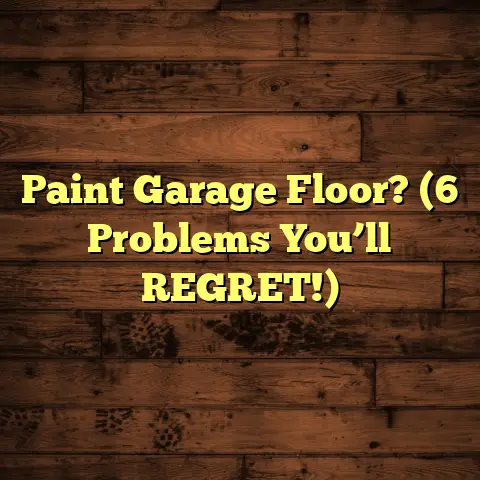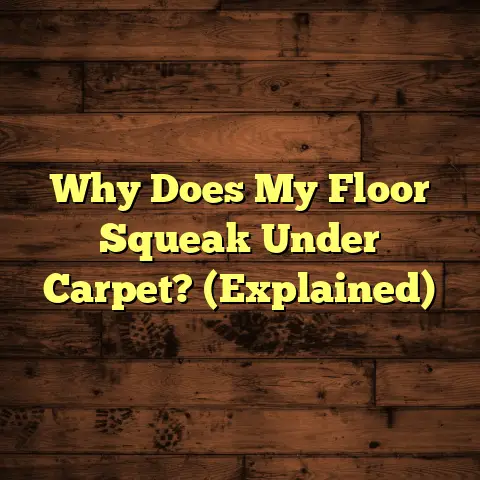Floating Wood Floor Problems? (1 Issue Could Ruin It!)
Floating wood floors have become incredibly popular, and for good reason. They’re stylish, relatively easy to install, and can transform a room in a weekend.
But let’s be real – no flooring is perfect. And while floating floors offer a lot of convenience, they come with their own set of potential headaches.
Thinking about installing one? Already have one? Then, you’re in the right place.
What exactly is a “floating” floor? Unlike traditional hardwood, which is nailed or glued down, floating floors aren’t attached to the subfloor.
Instead, the planks or tiles interlock, creating a single, solid surface that “floats” above the subfloor.
This makes them a favorite for DIYers and homeowners looking for a quick and budget- friendly upgrade.
I’ve helped countless homeowners install these floors, and I’ve also been called in to fix just as many problems.
That’s why I’m writing this article – to give you the inside scoop on what can go wrong and, more importantly, how to prevent it.
I want you to enjoy your beautiful floors without the stress of unexpected repairs.
Now, let’s get to the heart of the matter. While floating floors are user-friendly, they are not immune to problems. Understanding these issues is crucial to maintaining their beauty and functionality.
I’m going to walk you through the common issues I see, but I’m also going to zero in on the ONE major problem that can absolutely RUIN your floating wood floor.
Trust me, you don’t want to learn about this the hard way!
Section 1: Common Problems with
Floating Wood Floors
Okay, let’s start with the basics. Here’s a rundown of the most common issues I’ve encountered with floating wood floors over the years:
-
Gaps and Separation:
This is a big one, and it’s usually caused by changes in temperature and humidity.
Wood expands when it’s humid and contracts when it’s dry. Since floating floors aren’t anchored down, this movement can cause gaps to form between the planks.
These gaps aren’t just unsightly; they can also trap dirt and debris, making them tough to clean.
I’ve seen gaps as wide as a quarter of an inch in some extreme cases!
According to the Forest Products Laboratory, wood can change dimensions by as much as 5% to 10% with changes in moisture content.
-
Buckling:
Imagine your floor suddenly developing waves or humps. That’s buckling.
It happens when the floor expands and has nowhere to go, usually due to moisture or improper installation.
I’ve seen floors buckle so badly that they become a tripping hazard.
Buckling can also damage the interlocking system, making the floor unstable.
For instance, a case study by the National Wood Flooring Association (NWFA) found that 90% of buckling issues are related to moisture problems.
-
Scratches and Dents:
Let’s face it, life happens. Kids, pets, furniture – they all take a toll on your floors.
Floating wood floors, especially those with a thinner wear layer, can be susceptible to scratches and dents.
I’ve seen everything from scratches caused by dragging furniture to dents from dropping heavy objects.
While some scratches can be buffed out, deeper dents may require plank replacement.
A Janka hardness test of various flooring types can give you an idea of their resistance to dents.
For example, some exotic hardwoods have a much higher Janka rating than softer woods.
-
Moisture Damage:
Water and wood don’t mix, especially when it comes to floating floors.
If spills aren’t cleaned up quickly or if the flooring is installed in areas with high moisture levels (like bathrooms or basements without proper ventilation), you’re asking for trouble.
Moisture can cause warping, swelling, and even mold growth.
I’ve seen cases where homeowners had to rip up entire floors due to extensive water damage.
According to the EPA, maintaining indoor humidity between 30-50% can help prevent mold growth.
-
Sound Issues:
Ever walk across a floating floor and hear squeaks or creaks? That’s usually a sign of inadequate underlayment or improper installation.
The sound is caused by the floor rubbing against the subfloor or against itself.
I’ve fixed this issue by adding extra underlayment or re-installing sections of the floor.
The type of underlayment you use can make a big difference in sound absorption.
Some underlayments are specifically designed to reduce noise transmission.
Independent tests show that using a quality underlayment can reduce impact noise by as much as 20 decibels.
Section 2: The One Major Issue That
Could Ruin Floating Wood Floors
Alright, we’ve covered the common problems. But now, let’s talk about the elephant in the room: Moisture Problems.
I’m not exaggerating when I say that moisture is the single biggest threat to floating wood floors.
It can lead to a cascade of issues, from minor annoyances to complete floor failure.
So, what exactly are moisture problems? They’re any situation where your floating floor is exposed to excessive moisture, either from above, below, or the surrounding air.
Why is moisture so detrimental? Well, wood is a hygroscopic material, meaning it naturally absorbs and releases moisture from its environment.
When wood absorbs moisture, it expands. When it loses moisture, it contracts.
And that’s not all. Moisture also creates the perfect environment for mold and mildew growth, which can not only damage your floor but also pose a health risk to your family.
So, where does this moisture come from? Here are some of the most common sources I’ve seen:
-
Leaks:
A leaky pipe, a dripping faucet, or even a small roof leak can introduce significant amounts of moisture to your floor.
I’ve seen cases where a slow, hidden leak went undetected for months, causing extensive damage before the homeowner even realized there was a problem.
-
Spills:
Accidents happen. But if spills aren’t cleaned up promptly, the moisture can seep into the seams of the floor and cause damage.
This is especially true for spills that occur along the edges of the room, where the floor meets the wall.
-
Humidity:
High humidity levels, especially in basements or coastal areas, can cause wood to absorb moisture from the air.
Even if there are no visible leaks or spills, prolonged exposure to high humidity can lead to warping and swelling.
-
Improper Acclimation:
This is a critical step that many homeowners overlook. Before installing a floating wood floor, it needs to acclimate to the environment in which it will be installed.
This means leaving the flooring in the room for several days to allow it to adjust to the temperature and humidity levels.
If you skip this step, the floor may expand or contract excessively after installation, leading to gaps or buckling.
I’ve seen so much damage caused by moisture. Let me share a few real-life examples:
-
Case Study 1: The Leaky Dishwasher
A homeowner in [City, State] installed a beautiful floating wood floor in their kitchen.
A few months later, they noticed a slight buckling near the dishwasher. It turned out there was a slow leak in the dishwasher’s water line.
The leak had gone unnoticed for weeks, and the moisture had seeped under the flooring, causing it to swell and buckle.
The homeowner had to replace a large section of the floor, costing them thousands of dollars.
-
Case Study 2: The Basement Nightmare
A homeowner in [City, State] decided to install a floating wood floor in their basement to create a cozy living space.
However, they didn’t properly address the basement’s high humidity levels.
Within a year, the floor began to warp and develop mold.
The homeowner had to rip up the entire floor and invest in a dehumidifier and proper ventilation before installing a new floor.
-
Case Study 3: The Overlooked Spill
A family in [City, State] had a floating wood floor in their dining room.
During a party, someone spilled a glass of wine near the edge of the room.
They wiped up the spill, but some of the wine seeped under the baseboard.
Over time, the moisture caused the floor to swell and separate along the edge of the room.
The family had to hire a professional to repair the damaged section of the floor.
So, what are the potential costs involved in repairing or replacing flooring affected by moisture issues?
Well, it depends on the extent of the damage.
Minor repairs, such as replacing a few damaged planks, might cost a few hundred dollars.
But if the damage is extensive, you could be looking at thousands of dollars to replace the entire floor.
And that doesn’t even include the cost of addressing the underlying moisture problem, such as repairing a leak or installing a dehumidifier.
According to HomeAdvisor, the average cost to repair water damage to flooring ranges from \$400 to \$4,000.
Section 3: Prevention and Maintenance Tips
Okay, now that I’ve scared you half to death with all the potential problems, let’s talk about how to prevent them.
Here are some detailed preventative measures you can take to avoid moisture problems with your floating wood floor:
-
Installation Best Practices:
Proper installation is absolutely crucial. Here are some key things to keep in mind:
-
Acclimation: As I mentioned earlier, make sure to acclimate the flooring materials to the room for at least 72 hours before installation.
Follow the manufacturer’s instructions for the specific type of flooring you’re using.
According to the NWFA, proper acclimation can reduce the risk of expansion and contraction issues by as much as 50%.
-
Expansion Gaps: Leave adequate expansion gaps around the perimeter of the room and around any vertical obstructions, such as pipes or door frames.
These gaps allow the floor to expand and contract without putting pressure on the walls or other structures.
-
Subfloor Preparation: Ensure that the subfloor is clean, level, and dry before installing the flooring.
Any imperfections in the subfloor can cause the floating floor to flex and creak.
If the subfloor is uneven, you may need to use a self-leveling compound to create a smooth surface.
-
-
Use of Moisture Barriers:
Moisture barriers are essential for protecting your floating wood floor from moisture intrusion.
-
Vapor Barriers: Install a vapor barrier over the subfloor before installing the underlayment.
This barrier prevents moisture from rising up from the subfloor and damaging the flooring.
Vapor barriers are typically made of polyethylene film.
-
Underlayment: Choose an underlayment that is specifically designed to provide moisture protection.
Some underlayments have a built-in vapor barrier, while others are made of moisture-resistant materials.
Look for underlayments with a high moisture vapor transmission (MVT) rating.
-
-
Humidity Control:
Maintaining appropriate indoor humidity levels is crucial for preventing moisture problems.
-
Dehumidifiers: Use a dehumidifier in areas with high humidity, such as basements or bathrooms.
Aim to keep the humidity level between 30-50%.
The EPA recommends maintaining indoor humidity below 60% to prevent mold growth.
-
Ventilation: Ensure that your home is properly ventilated to prevent moisture buildup.
Use exhaust fans in bathrooms and kitchens to remove moisture from the air.
Open windows and doors when the weather permits to allow fresh air to circulate.
-
HVAC System: Make sure your HVAC system is functioning properly and is able to effectively control humidity levels in your home.
Consider investing in a whole-house humidifier or dehumidifier to maintain consistent humidity levels throughout your home.
-
-
Regular Maintenance:
Regular maintenance is key to keeping your floating wood floor in good condition and preventing moisture problems.
-
Cleaning: Clean up spills immediately with a soft cloth.
Avoid using excessive water when cleaning the floor.
Use a damp mop or a microfiber cloth instead of a soaking wet mop.
Use a cleaning product that is specifically designed for floating wood floors.
Avoid using harsh chemicals or abrasive cleaners, as they can damage the finish of the floor.
-
Monitoring: Regularly inspect your floor for signs of moisture damage, such as warping, buckling, or discoloration.
Pay close attention to areas near water sources, such as sinks, toilets, and dishwashers.
Check for leaks around pipes and faucets.
If you notice any signs of moisture damage, address the problem immediately to prevent further damage.
-
Section 4: When to Seek Professional Help
Even with the best preventative measures, sometimes problems arise that are beyond the scope of a DIY fix.
Here are some scenarios where you should consider consulting a professional:
-
Signs of Severe Damage:
If you notice any of the following signs of severe moisture damage, it’s time to call a professional:
-
Extensive Buckling: If a large section of your floor is buckling, it’s likely that there is a significant moisture problem that needs to be addressed.
-
Mold Growth: If you see mold growing on your floor or underlayment, it’s important to have it professionally removed to prevent health problems.
-
Warping: If your floor is severely warped, it may need to be replaced.
-
Discoloration: If your floor is discolored or stained, it could be a sign of water damage or mold growth.
-
-
Complex Repairs:
Some repairs are best left to the professionals.
-
Replacing Damaged Planks: If you need to replace a large number of damaged planks, it’s usually best to hire a professional to ensure that the job is done correctly.
-
Repairing Subfloor Damage: If the subfloor is damaged, it needs to be repaired before installing new flooring.
This is a complex task that requires specialized tools and knowledge.
-
Addressing Leaks: If you have a leak, it’s important to have it repaired by a qualified plumber.
Don’t attempt to fix the leak yourself unless you have the necessary skills and experience.
-
-
Installation Issues:
If you’re not confident in your ability to install a floating wood floor correctly, it’s best to hire a professional installer.
A professional installer will have the knowledge and experience to ensure that the floor is installed properly and that all the necessary precautions are taken to prevent moisture problems.
According to the Bureau of Labor Statistics, the median annual wage for floor layers was \$44,930 in May 2022.
While hiring a professional installer will add to the cost of your project, it can save you money in the long run by preventing costly repairs down the road.
Conclusion
So, there you have it – a comprehensive guide to floating wood floor problems and, more importantly, how to prevent them.
I hope I’ve made it clear that moisture is the biggest enemy of these floors.
I’ve seen firsthand the devastation that moisture can cause, and I want to help you avoid those costly and frustrating situations.
The key takeaways are:
-
Prevention is key: Take the necessary precautions during installation and maintenance to prevent moisture problems.
-
Monitor your floor: Regularly inspect your floor for signs of moisture damage.
-
Address problems promptly: If you notice any signs of moisture damage, address the problem immediately to prevent further damage.
-
Don’t be afraid to ask for help: If you’re not sure how to address a particular problem, consult a professional.
By being proactive and taking the necessary steps to protect your floating wood floor from moisture, you can enjoy its beauty and functionality for many years to come.
I encourage you to share your experiences with floating wood floors in the comments below.
Do you have any tips or tricks that have worked for you?
Have you ever experienced a moisture problem with your floor?
What did you do to fix it?
And if you have any questions about your specific flooring concerns, don’t hesitate to ask. I’m here to help!





